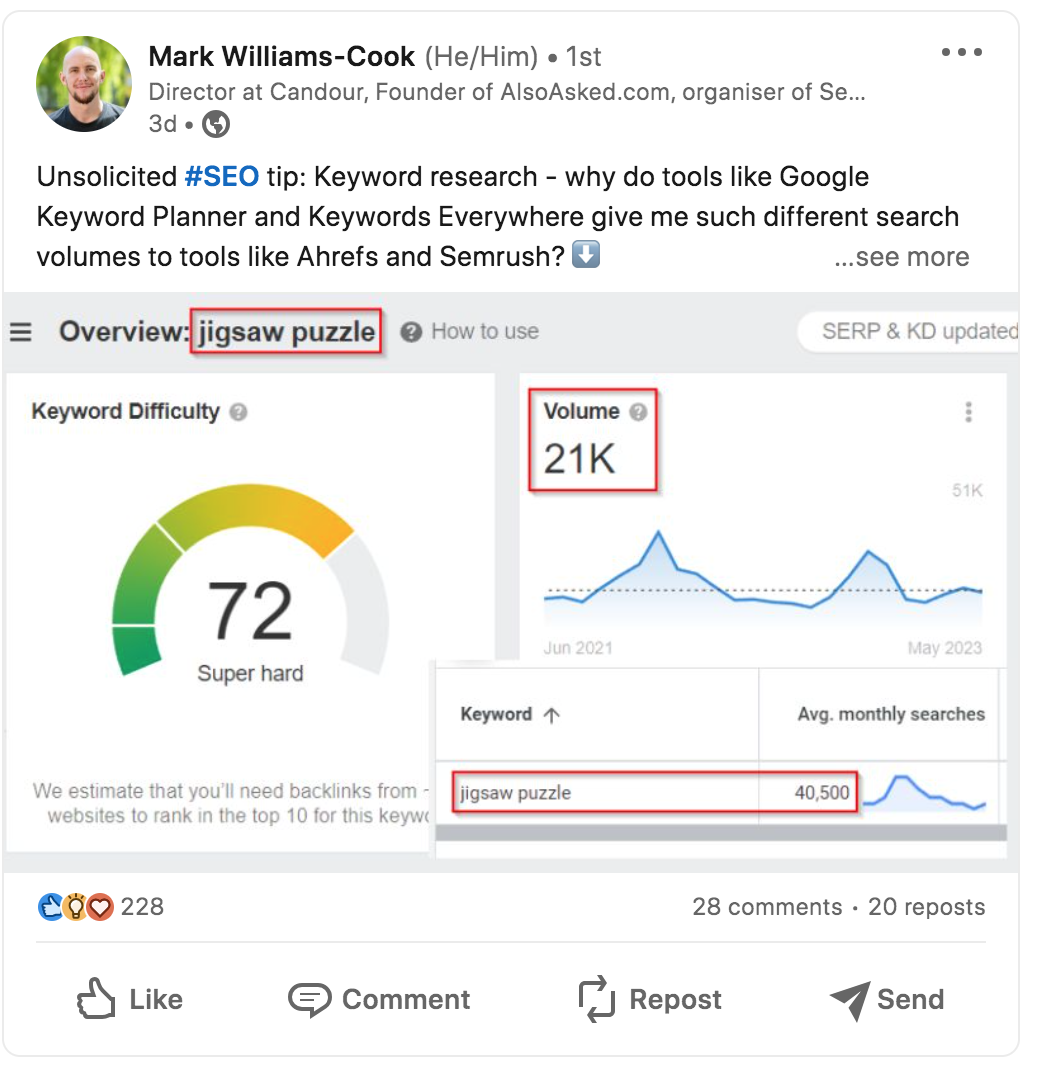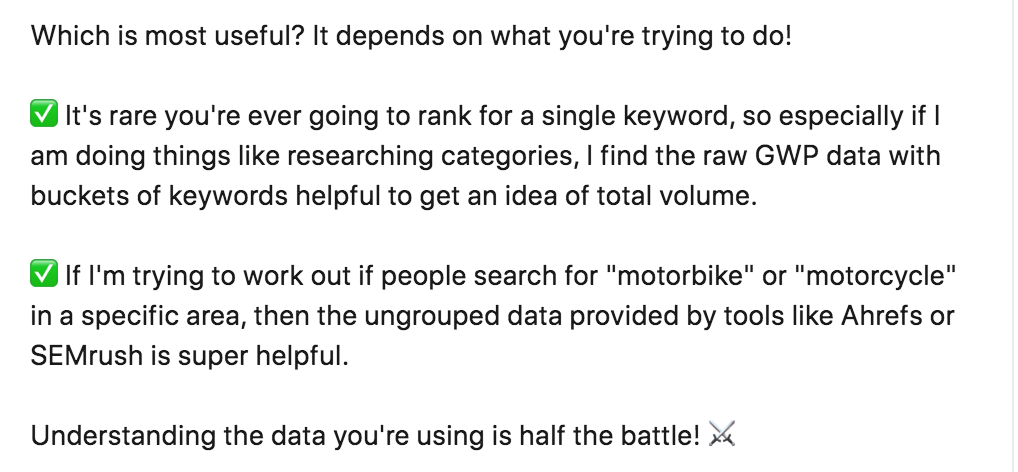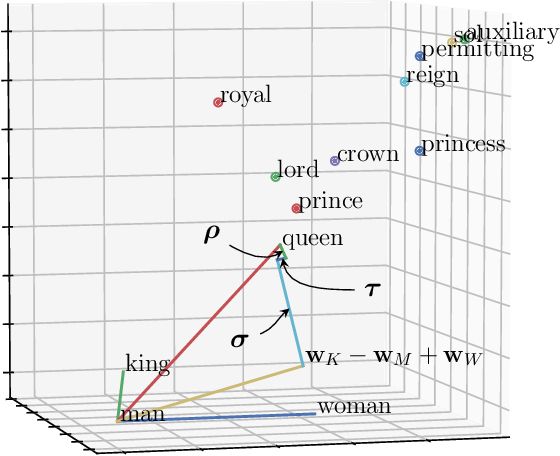SEO & Content Marketing Talk
Random observations about search optimization and content marketing from experts I follow online. I’ll always credit the author and link to the source where possible.
Why Semrush, Ahrefs and Google Keyword Planner Report Different Search Volumes
Aug. 17, 2023
My LinkedIn feed continues to be a gold mine, particularly thanks to Mark-Williams Cook and his SEO Tips.

💬 Google Keyword Planner (and related tools such as Keywords Everywhere) are putting sets of keywords into “buckets”. That means that similar terms such as “jigsaw puzzles” (plural) and other similar terms are grouped together to give a total volume of 40,500.
💬 Ahrefs does use Google Keyword Planner data but attempts to “ungroup” similar keyword clusters and refine search volumes from GKP using several additional sources of data and custom click-through rate (CTR) distribution models.
💬 SEMrush uses its own “algorithms” to come up with another different number, but closer to Ahrefs than KWP.
Mark tells us it isn’t that one source isn’t correct or incorrect; they each (along with MOZ’s keyword explorer, I’m sure) have their place:

Here’s a short clip from Mark’s SEO course that covers this; full course is here.
ChatGTP Plugin Lets You Identify And Fix Low-CTR/High-Rank Pages
Aug. 2, 2023
Tony Hill shows us how he’s using Code Interpreter (available if you pay for a “ChatGPT Plus” plan) to write page titles for low-CTR pages.
I’ve been using ChatGPT’s new Code Interpreter to increase the CTR of my highest-ranking but lowest-clicked pages in Google.
— Tony Hill (@tonythill) August 1, 2023
Once it knows which title tags perform best for my site, I find it suggests much better ones🤌
Here’s how I do it in 7 steps 👇
“I’ve been using ChatGPT’s new Code Interpreter to increase the CTR of my highest-ranking but lowest-clicked pages in Google. Once it knows which title tags perform best for my site, I find it suggests much better ones”
Consider A ‘Sticky’ Navigation Menu
Aug. 1, 2023
Ross Hudgens over at Siege Media has some hard numbers showing the benefits of a menu bar that “freezes” in place in the user’s browser window …:
Implementing a sticky navigation increased goal conversions by 39% on our B2B blog.
— Ross Hudgens (@RossHudgens) August 2, 2023
It also improved time on site and bounce rate metrics.
This is a common best practice, but good to see data strongly supporting making the change as well. pic.twitter.com/wKPM2uTp0D
Best Practices For Driving Value From SEO Content Updates
March 23, 2023
Ross Hudgens over at Siege Media had some good tips in a LinkedIn post regarding how to handle a blog content refresh. Here’s my summary:
- Look at the distance between the newest and oldest timestamp on the search result. Aim to consistently be in the top 75th percentile of freshness.
- When in doubt, update once per year. Content that’s a year old is a leading indicator of lost rankings.
- Evaluate SERP changes to inform content updates. Search intent changes over time. What worked for ranking in 2020 may not work for ranking today.
- Think of how content will be updated when it gets created. Don’t use numbers (such as the current year!) that will get outdated in images and are hard to update.
Check out Ross’s full post for more. And to learn more about the Siege approach (and to see Ross disregarding his own advice right there in the headline!) check out How To Conduct an SEO Content Audit in 2023.
How SEOs Can Better Partner With Development Teams
March 13, 2023
Self-promo time! It’s great to get a shoutout from the SEMrush blog!
This one is all about how SEO professionals can move their initiatives forward within the context of the larger organization—by navigating the various stakeholders and by understanding the context of their respective priorities.
SEO is a busy job involving lots of moving parts, and it can be frustrating when we can’t see results quickly because change requests are backing up in the developer queue.
The article says two-thirds of the SEOs SEMrush surveyed said they wait a month or more to get their changes implemented, and 40% of those changes are actually never implemented at all. That’s why it pays to get to know the design and development teams’ existing development priorities:
Displaying empathy and mutual understanding goes a long way in allowing marketers and developers to work together toward optimum performance for business websites.
SEO In Multidimensional Space
February 24, 2023
Michael King, Founder of iPullRank, posted about embeddings on LinkedIn. It’s a great way to think about how Google prioritizes content today vs. its approach years ago.
Update those SEO skills, y’all …
So many of the innovations that Google has made in the past ten years are related to embeddings.
If you haven’t heard of them, the easiest way to think of it is that words and concepts are represented as vectors in multidimensional space (like the image below).
Converting real-world concepts into vectors allows you to do mathematical operations on them. That is what has unlocked many of the advancements we’ve seen where Google has grown beyond the clever rules-based based system we knew it to be.
One of the common mathematical methods used is called “cosine similarity” which (basically) can be used to calculate what other thing plotted in this multidimensional space is physically closest to the thing I’m examining.
One of the coolest examples that was shown in the paper for Word2Vec back in 2013 is that you could subtract the vector for the word “man” from the vector for the word “king” and add the vector for the word “woman” and then the resulting closest vector would be the word “queen.”
That was 2013—way before Transformers, BERT, or GPT-anything. Obviously, things have advanced quickly and dramatically.
Google’s ranking systems have contemplated Word Vectors, Website Context Vectors, Author Vectors, etc.
Yet, in SEO we’re still talking about word counts and domain authority and our tools are measuring a series of simple rules.
Subscribe to the Rank Report Newsletter and get SEO and content strategy tips every 2 weeks.
Does Your Business Need Brand Journalism?
January 19, 2023
A recent email from Allie Decker over at Omniscient Digital had some things to say about how businesses can create thought leadership content. She talked about story-led thought leadership (aka brand journalism) as being a tough content play because (quoting Allie):
- It’s near impossible to measure results if you’re only looking at keyword movements and organic traffic (as most content marketers are)
- Topic ideation is super manual and requires being very in touch with your team and your industry
In my experience, story-led thought leadership (brand journalism) content needs a boatload of distribution support because these pieces aren’t (and IMO shouldn’t be) search-optimized. So you can’t expect to measure success through Ahrefs and organic traffic reports.
This is where targeted social and email distribution comes into play.
For every story-led piece, expect to repurpose the content into 5+ LinkedIn posts and Twitter threads (or Facebook or Quora or Reddit or wherever, depending on your readership). Plug that piece into every email newsletter you can get your hands on. Encourage your featured thought leaders to promote it on their channels. Add links to your story-led articles to your search-friendly pieces, too.
Change your schema markup to identify these pieces as “News.” Then you have a better shot of them showing up in some Google results, provided someone searches for a relevant query.
How do we come up with ideas for content when we’re focused on brand journalism? Again, here’s Allie:
I also plugged myself into nearly every Slack channel led by the Product, Sales, and Dev teams. They’d sometimes share a win and I’d think, “Hold on—let’s write something about that.” This method was great for brainstorming brand and product-related stories.
If you’re trying to surface new stories within your organization, it’s hard to just ask people if they have any new information. You have to discover those stories passively and build trust with folks who aren’t yet used to talking about themselves and their wins.
By reaching out to internal and external experts with specific questions already inspired by the SERPs, you start to build a network that you can later tap into for story ideas. Better yet, these SMEs will know to come to you with new ideas, too.
Subscribe to Omniscient Digital’s “Field Notes.”
Email Deliverability Problems?
Aug. 3, 2022
Some mail providers are seeing an increase in rejected emails from Gmail with the following message:
“Our system has detected that this message is likely unsolicited mail. To reduce the amount of spam sent to Gmail, this message has been blocked. Please visit https://support.google.com/mail/?p=UnsolicitedMessageError for more information.”
It appears that Google made a significant change to their spam filters on June 6, 2022. Texas-based email host MXroute reports that “Every customer who has noticed this and opened a ticket with us has one thing in common: They did not comply with our policy and set a proper SPF record in their DNS.”
Their support documentation reviews the basics of DNS records. Check yours with your provider if you are having problems.
